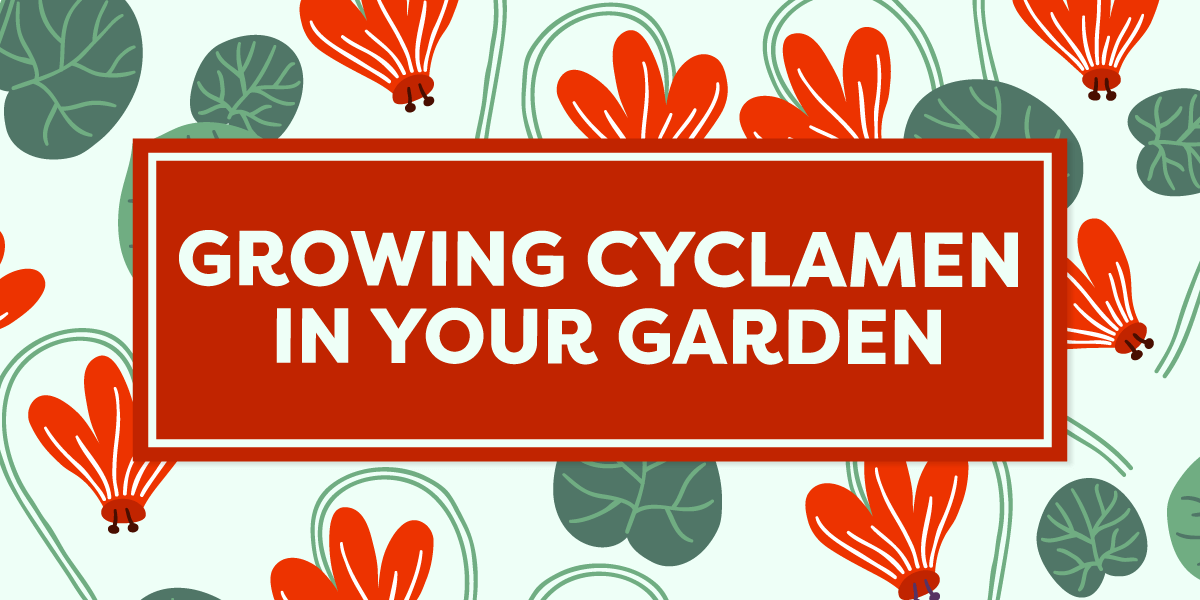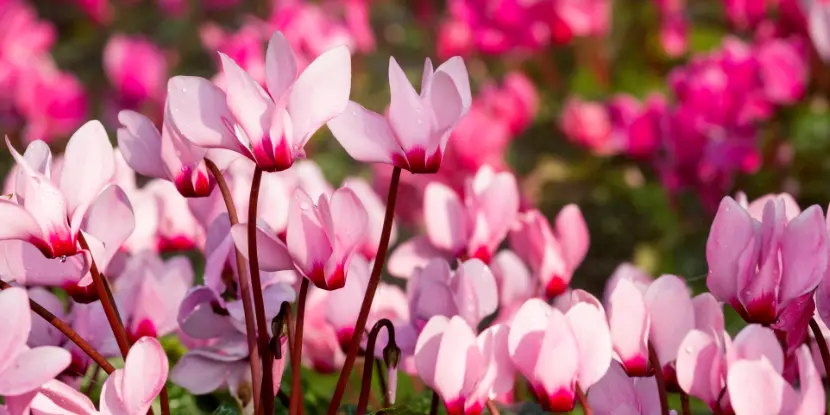Cyclamens are tuberous-rooted perennials grown for their beautiful flowers that resemble shooting stars.
They’re native to the Middle East, Cypress, and Crete and are commonly called “Sow Bread” because pigs eat their large roots.
Their tubers contain “cyclamin,” harmless to pigs but can cause gastritis and nervous tension in humans if ingested.
Roasting destroys the toxicity. In ancient times, tubers were roasted, beaten, and made into small cakes, which were considered an aphrodisiac. Much of the folklore about cyclamen refers to love and conception. The plant was deemed so potent that it was dangerous for a pregnant woman to even step on it.
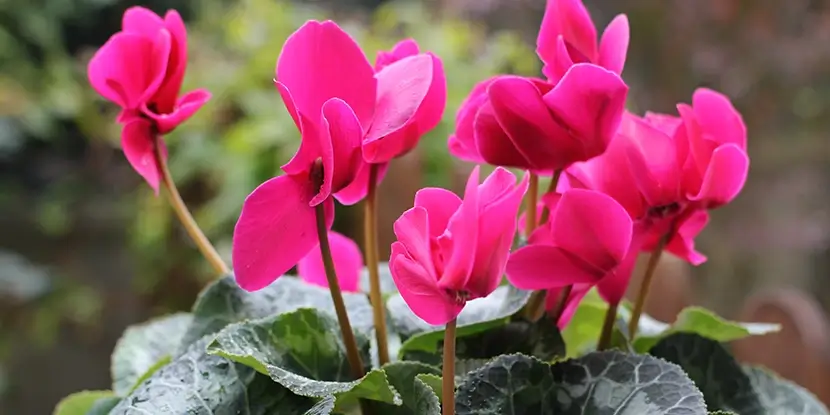
Look but don’t eat! Blooming hot pink cyclamen.
Supposedly, cyclamens could also:
- Heal snake bites
- Ward off magic spells
- Influence affairs of the heart
- Bring good luck
Cyclamen persicum is the wild ancestor of the florist cyclamen. The name “cyclamen” comes from “kuklos,” meaning circle, derived from the spiraling action of cyclamen seeds after pollination. The stem coils and spirals downward, wrapping around the fertilized seed pod and facilitating the scattering of seeds onto the ground.
Blooming
The original species has pale pink or white 2-inch fragrant flowers on 6-inch stems. Selective breeding has given us large flowers which have lost their fragrance.
Today’s cyclamens bloom in late fall to spring in many colors: crimson, red, rose pink, salmon, purples, and white. The flowers are usually large, uniform, 3 to 4 inches, borne on 6 to 8-inch stems above kidney-shaped, dark green leaves.
Dwarf or mini cyclamens are ideal windowsills. While regular-sized cyclamen are about 10 inches tall, with flowers an inch in diameter, mini cyclamens can be as small as 2 to 4 inches tall.
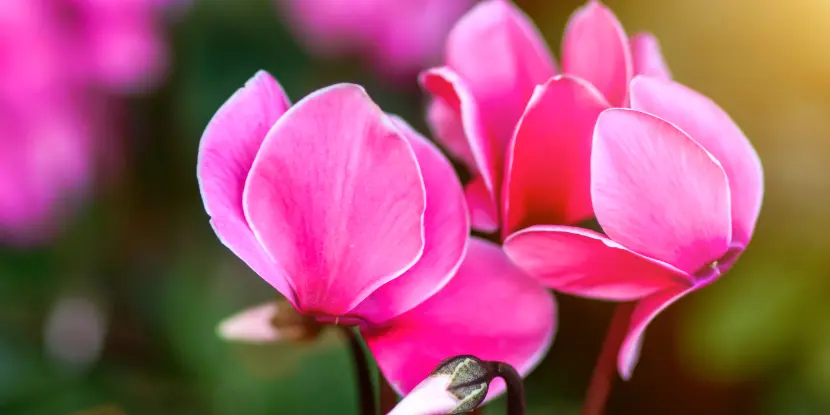
Close-up of a pink cyclamen bloom.
Growing Conditions
Due to their tender nature, florist cyclamens are typically grown indoors. Other hardy types can thrive in outdoor settings, particularly in cooler regions.
Therefore, depending on the variety and local climate, cyclamens can be cultivated indoors and outdoors in Southern California.
Soil
- Well-drained, slightly acidic soil.
- A mix of equal parts potting soil, peat moss, and perlite or sand.
- Keep soil moist but not saturated to avoid tuber rot.
Light
- Cyclamens prefer bright, indirect light.
- They flourish under dappled sunlight or in partial shade.
- Avoid direct, harsh sunlight, which can scorch the leaves and flowers.
Temperature
- Cyclamens grow best between 50°F to 65°F (10°C to 18°C).
- They’re sensitive to heat and don’t perform well in temperatures above 70°F (21°C).
- Protect them from frost; freezing temperatures can damage the plants.
Planting Cyclamens from Seed
Indoor Planting
Soil Preparation
- Prepare a potting mix of equal parts potting soil, peat moss, and perlite or sand.
- Ensure the soil is slightly acidic and well-draining.
Sowing Seeds
- Soak cyclamen seeds in warm water for 24 hours to soften the seed coat.
- Fill seed trays or small pots with the prepared soil mix.
- Sow seeds on the soil surface and cover them lightly with a thin layer of soil about 1/4 inch deep.
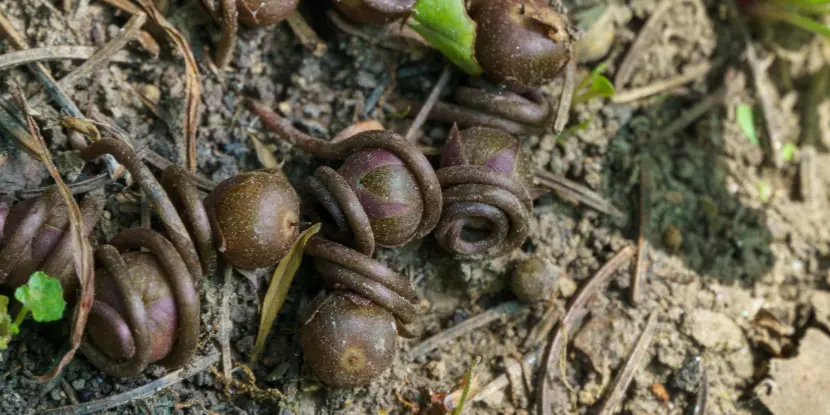
Cyclamen seeds wrapped by their stems.
Watering
- Water the soil gently to keep it moist but not saturated.
- Maintain consistent moisture levels to encourage germination.
Light & Temperature
- Place seed trays in a location with bright, indirect light.
- Maintain a temperature between 60°F to 70°F (15°C to 21°C) for optimal germination.
- Avoid exposing seeds to direct sunlight, which can dry out and scorch the soil.
Germination
- Cyclamen seeds typically take 3-6 weeks to germinate.
- Be patient and continue to monitor moisture levels during this period.
Outdoor Planting
Soil Preparation
- Choose a planting site with well-drained soil enriched with organic matter.
- Amend the garden soil with peat moss and perlite or sand to improve drainage.
Sowing Seeds
- Soak the seeds in warm water for 24 hours before planting.
- Sow the seeds directly into prepared garden beds, covering them with a thin layer of soil about 1/4 inch deep.
Watering
- Water the soil thoroughly after planting to settle the seeds.
- Maintain a consistent moisture level, ensuring the soil stays damp but not soggy.
Light & Temperature
- Select a planting site that receives dappled sunlight or partial shade.
- Ensure the outdoor temperatures are within the range of 50°F to 65°F (10°C to 18°C) for healthy growth.
- Protect newly planted seeds from extreme cold or frost.
Germination
- Cyclamen seeds planted outdoors may take longer to germinate, ranging from 4-8 weeks.
- Regularly check for germination signs and water as needed to keep the soil moist.
Water & Fertilizing
Watering Cyclamens
- Keep the soil consistently moist, but avoid waterlogging the tubers.
- Water from the bottom to prevent moisture from sitting on the foliage, which can cause fungal diseases.
- Water when the top inch of soil feels dry to the touch, usually once a week, adjusting for indoor humidity levels.
- Use room temperature water to avoid shocking the plant roots.
- As cyclamens enter dormancy after the blooming period, reduce the watering frequency, allowing the soil to dry out more between watering sessions.
Fertilizing Cyclamens
- Use a balanced, water-soluble fertilizer (e.g., 10-10-10 or 20-20-20).
- Fertilize every 2-4 weeks during the active growing season, from late fall to spring.
- To avoid root burn, dilute the fertilizer to half the recommended strength and apply it directly to the soil, not the foliage.
- Cease fertilization during dormancy, as over-fertilizing can harm dormant tubers.
- For gentler, long-term nourishment, use organic fertilizers like fish emulsion or compost tea.
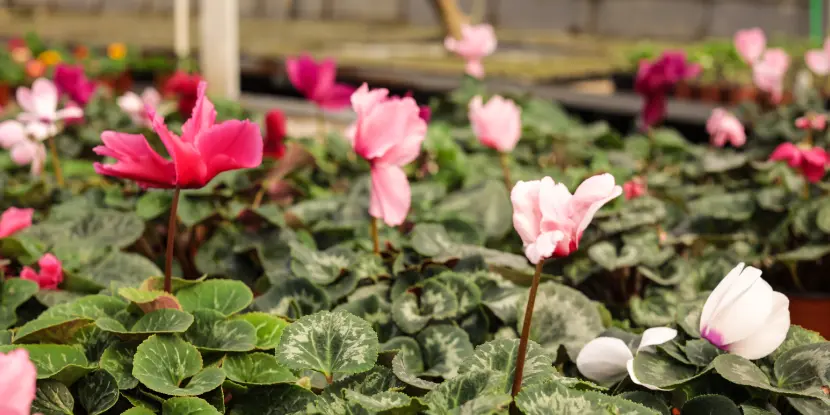
Pink cyclamens growing in a greenhouse.
Dealing with Common Pests & Diseases
Pests
Aphids
Small, green or black insects on leaves and stems.
- Spray plants with a strong stream of water to dislodge aphids.
- Apply insecticidal soap or neem oil to affected areas.
- Encourage beneficial insects like ladybugs to visit your garden.
Spider Mites
Tiny, spider-like insects and fine webbing on the undersides of leaves.
- Increase humidity around the plants; spider mites thrive in dry conditions.
- Use miticides or horticultural oil to treat infestations.
- Regularly mist the plants and keep them clean.
Fungus Gnats
Small, dark flies hovering around the soil.
- Let the soil dry between watering to disrupt their breeding cycle.
- Use yellow sticky traps to catch adult gnats.
- Ensure good drainage and avoid overwatering.
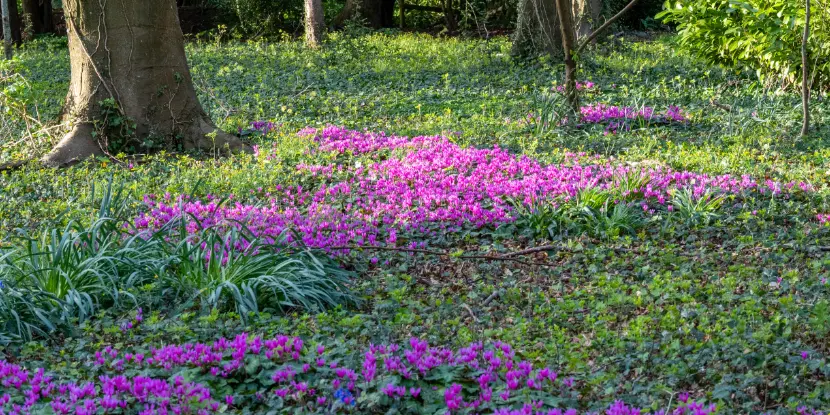
Cyclamen growing wild in a coastal area.
Common Diseases
Botrytis Blight (Gray Mold)
Gray, fuzzy mold on flowers and foliage.
- Remove and dispose of affected plant parts.
- Use fungicides like copper or sulfur-based products.
- Maintain good air circulation and keep the foliage dry.
Powdery Mildew
White, powdery patches on leaves and stems.
- Spray plants with a mixture of water and baking soda.
- Apply fungicides specifically formulated for powdery mildew.
- Provide adequate spacing between plants and avoid overhead watering.
Cyclamen Mite Infestation
Small, almost invisible mites causing distorted, stunted growth.
- Isolate affected plants to prevent spread.
- Use miticides or insecticidal soaps.
- Regularly inspect new plants and maintain clean growing conditions.
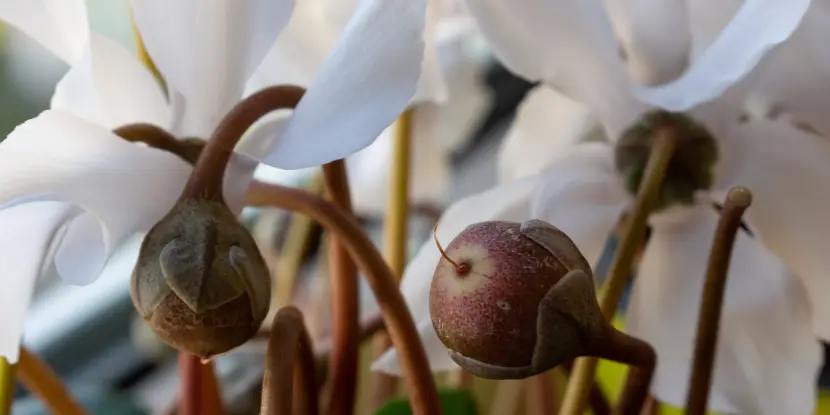
Close-up of cyclamen buds.
Propagating Cyclamens
Propagating via Tubers
- Select healthy, mature cyclamen plants with well-formed tubers.
- Gently dig up the plant, taking care not to damage the tubers.
- Use a sterile, sharp knife to cut the tuber into sections, ensuring each piece has at least one growth node or “eye.”
- Allow the cut tubers to dry for a few hours to form a callus, which helps prevent rot.
- Prepare a potting mix of equal parts potting soil, peat moss, and perlite or sand.
- Plant the tuber sections in the soil mix, with the eyes facing upwards, just below the surface.
Propagating via Seeds
Please refer to the section above, “Planting Cyclamens from Seed.”
FAQs: Cyclamen Care
Q: How often should I water my cyclamen?
Water cyclamen plants thoroughly when the soil feels dry, ensuring you don’t waterlog the soil, as this can lead to root rot.
Q: Can cyclamen plants tolerate direct sunlight?
Cyclamen prefer indirect or filtered light; direct sunlight, especially during the hotter parts of the day, can be harmful to the plants.
Q: When is the best time to plant cyclamen bulbs?
A: Plant cyclamen tubers in late summer, before the fall blooming season, when temperatures cool.
Q: What should I do with my cyclamen after it has finished blooming?
After blooming, cyclamen go dormant. Reduce watering and allow the leaves to yellow and die before removing them. Move the plant to a cooler, shaded area until new growth begins.
Q: Are there any common pests I should watch for on my cyclamen plants?
Cyclamen are relatively resistant to pests, but keep an eye out for common insects like aphids and spider mites, which might be attracted to the plants.
Q: How can I encourage my cyclamen to bloom?
Keep the plant in a cooler environment with temperatures between 50 and 65 degrees F, and follow a regular fertilization schedule with a blooming plant fertilizer.
Q: Can cyclamen survive an indoor environment during their blooming period?
Yes, cyclamen can thrive indoors during their blooming period if they have sufficient light and are kept in a cool room away from direct heat sources.
Q: How can I propagate cyclamen plants?
Cyclamen can be propagated by seed or division of the tubers during their dormant period after the foliage has died.
Q: What are the signs that my cyclamen is unhealthy?
Yellowing leaves, wilting, or mold on the soil indicate that cyclamen may be overwatered, underfed, or exposed to incorrect temperatures.
Q: Can cyclamen withstand frost?
Cyclamen aren’t frost-tolerant. They should be protected or brought indoors to prevent damage if grown in areas with frost risk.
Q: Are cyclamens toxic to pets?
Yes, cyclamens can be toxic to pets if ingested. Keep them out of reach of curious animals.
Q: Do cyclamens bloom year-round?
While cyclamens are known for their long blooming season, they typically go through dormant periods. You can enjoy their blooms for several months each year with proper care.

